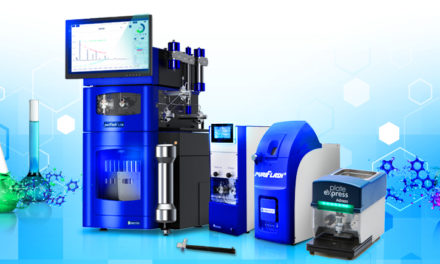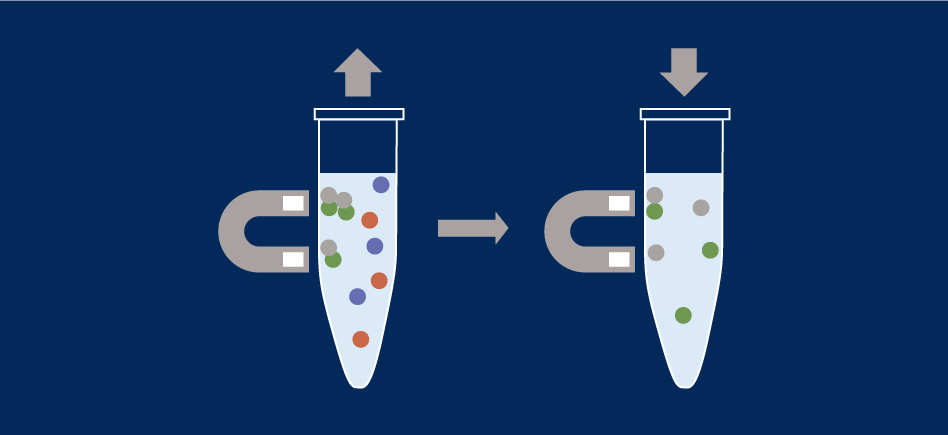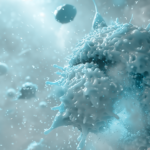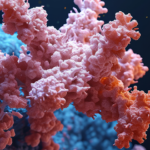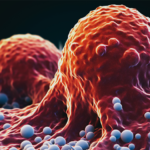1. Introduction
The improvements of analytical techniques and methodological tools play an important role for the characterization and isolation of bioactive secondary metabolites in natural product research. Reversed phase liquid chromatography MS (RP-LC-MS) is widely used for the metabolite profiling of complex natural extracts at the analytical level and start to be more and more used for targeted MS isolation of biomarkers. Normal phase chromatography (NP-LC) is well suited for the purification of apolar
secondary metabolites offering also some advantages compared to RP like low operating pressures and cheapest stationary phases.
NP-LC however is not well compatible for hyphenation with MS. The potential of NP-LC-APCI-MS for metabolite purification at the preparative scale using generic separation methods has been investigated on medium pressure preparative chromatography system (PuriFlash® – MS) in view of its application for targeted MS isolation of lipophilic secondary metabolite. A mixture of three representative apolar natural products was used to optimise separation, splitting and MS ionisation in conditions mimicking real isolation cases. Finally, a successful isolation of the apolar constituents of the dichloromethane roots extract of Angelica archangelica was performed.
2. Rapid Isolation of a representative apolar natural product mixture by normal-phase Flash Chromatography-APCI/MS
A. Purification of a natural products mixture on 12g and 25g Normal phase flash column
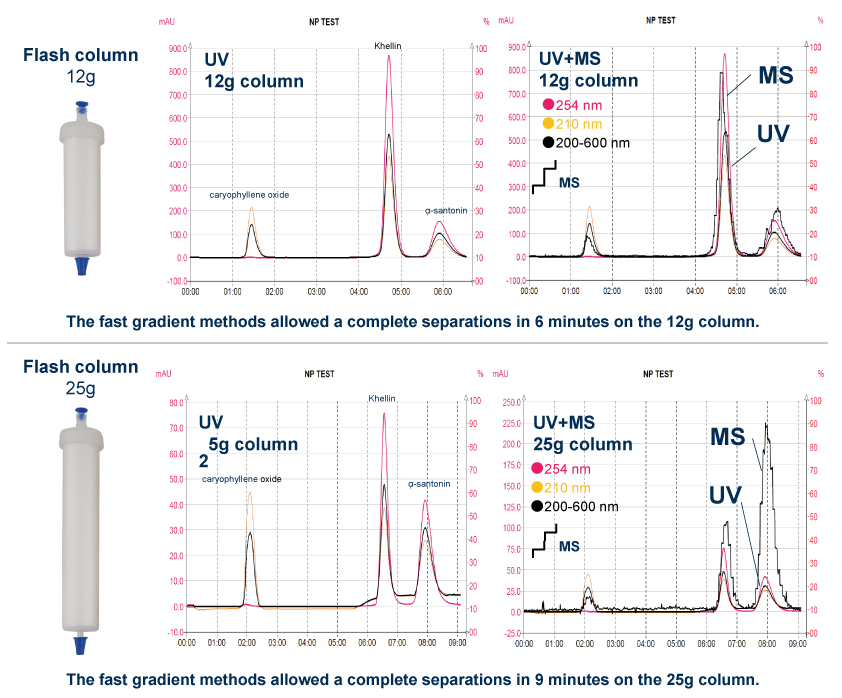
Three commercially available standards (caryophyllene oxide, khellin and alpha-santonin) were chosen in order to evaluate the applicability of Flash UV/APCI MS system as a tool for rapid purification of lipophilic compounds from crude plant extracts.
The four chromatograms show the mixture profile at the preparative scale with rapid gradients on two column sizes with a good overlap of the UV and MS signals.
All parameters were carefully optimised for both separation and detection. A special care was taken to find ionization and splitting conditions that provide good detection and preclude source contamination.
B. Flash – MS guided purification of a given compound
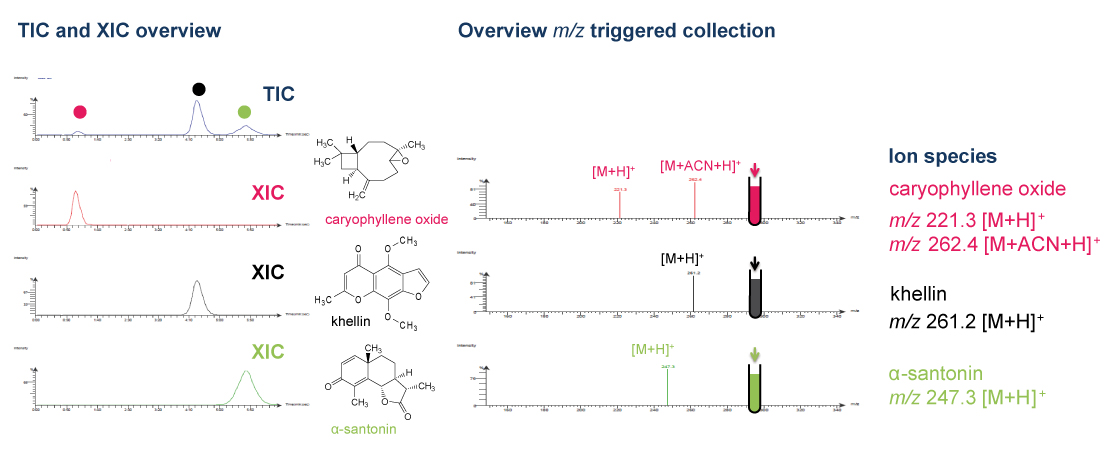
C. Scheme of the post column make-up pump dilution

– Flow: 20ml/min
– A:Hexane+0.1% F.A. B: Isopropanol+0.1%F.A.
– Column: Puriflash SIHP Column 15μm 12g-25g
– Natural prod Mixture concentration: 40mg/ml
– Inj. Volume: 500μl
– Dilution solvent: ACN or MeOH +0.1%FA
– MS scan time:1500ms
– MS Scan Range: m/z 200 – m/z 800
– MS Ionization Method: APCI
– APCI parameters:
Polarity: Positive Ion (+)
Capillary temperature: 200°C
Source gas temperature: 280°C
Capillary voltage: 180V
APCI corona discharge: 5V
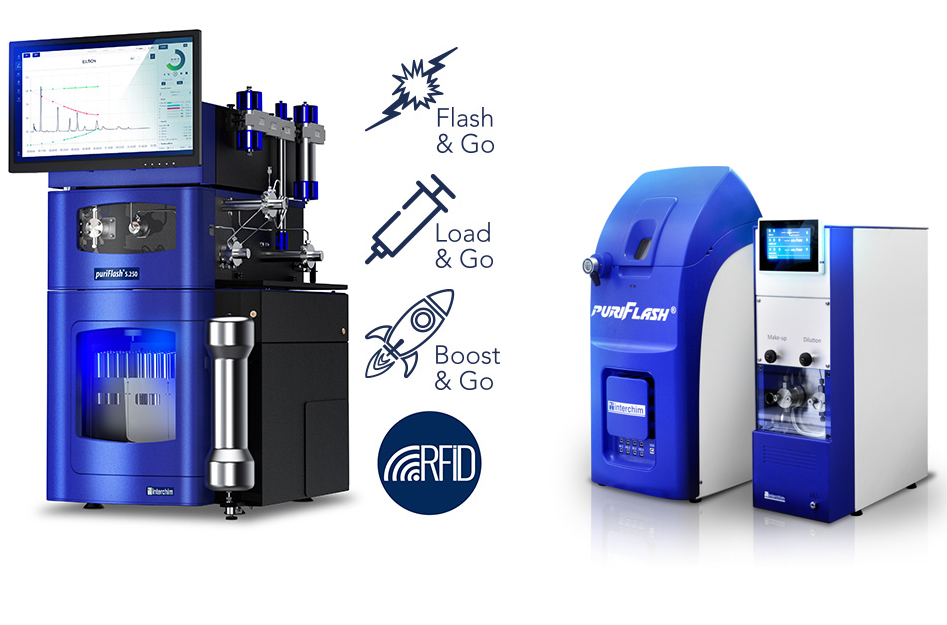
Flash Chromatography-APCI/MS system
| For the APCI source the highly flammable solvents coming from the normal phase should be avoided because of the heating process and special caution has to be taken.
In order to have an efficient and safe ionization an optimized post column dilution was thus mandatory. The solvent mixture finally reaching the MS detector was at > 99% either ACN or MeOH. APCI-MS detection with optimized splitting conditions and post-column elution of appropriate solvent was found robust and well suited for this type of purification. |
Dynamic Split optimized parameters |
Compact benchtop single quadrupole APCI/MS system |
 |
 |
3. NP MS purification of Angelica archangelica roots extract under Normal-Phase conditions

Analytical HPLC-UV
 |
 |
Analytical scale:Column length (L1): 250mm |
|
Preparative scale:Column length (L2): 140mm |
|
Suggested Flow rate: 30mL/min
Suggested Vinjection: .33mL
Backpressure change: ± 3.3
Efficienty change: ±1.8
Analysis time change: x 1.0
Solvent consumption: x 12.5
 Geometrical transfer
Geometrical transfer
Flash Preparative UV-ELSD-MS

The roots of Angelica are rich in coumarin derivatives
| MS-ELSD detection in complement with UV detection enabled the monitoring of secondary metabolites with no or weak chromophores and the selectivity of the MS was of great help for a precise collection of partially coeluting compounds. |  |
4. Conclusion
Normal phase flash purification represent an efficient strategy for a rational isolation of specific lipophilic biomarkers or bio-active compounds based on metabolite profiling results. The MS-triggered fractionation and ELSD monitoring in addition to standard UV detection is a powerful tool for a precise collection and to estimate the amount of separated compounds. MS is particularly useful for the specific collection of a given m/z feature in case of coelution that often occur in crude extracts using high loading and low peak capacity chromatographic methodologies. This fast and rational approach can be widely used for single step purifications and isolation of synthetic and natural mixtures. It is also compatible for the detection of apolar compounds that lack chromophores which is very common in natural product research. Separation performed at the preparative scale allows to purify tens to hundreds mg of compounds for further structural identification and assessment of their bioactivities.
5. References
Davide Righi1, Antonio Azzollini1, Emerson Ferreira Queiroz1, Jean-Luc Wolfender1
School of pharmaceutical sciences, University of Geneva, University of Lausanne, 30 Quai Ernest-Ansermet, 1211 Geneva 4, Switzerland
[1] Davy Guillarme, Dao T.T. Nguyen, Serge Rudaz, Jean-Luc Veuthey, Eur. J. Pharma. Biopharma. 2008, 68, 430
Know more:
You will be able to find this article in the new Interchim catalogue on Natural products. You will have a great choice of products among 8000 natural compounds offered; these products will be divided in three parts : chemicals, screening compounds, and bulks. To make things easier an alphabetical list will available in each part, as well as a CAS number index at the end of the catalogue.
 |
The Natural Products catalogue will be available soon for download on our website www.interchim.com |
Know more about our mass spectrometers puriFlash® MS & MS Splitter.





